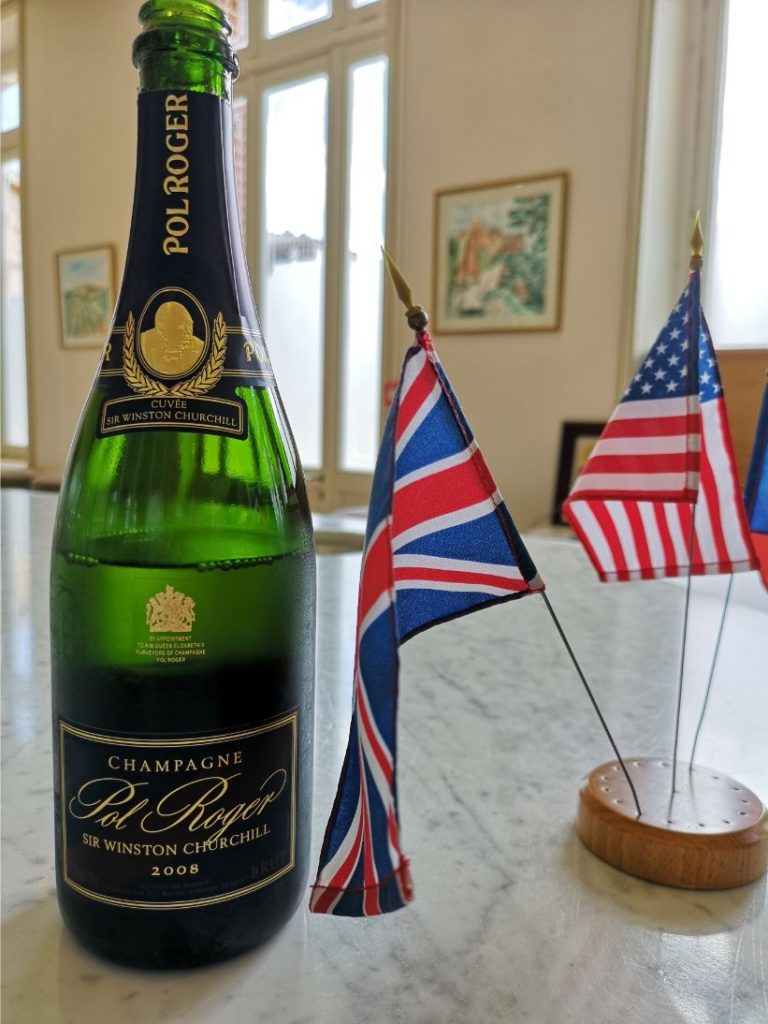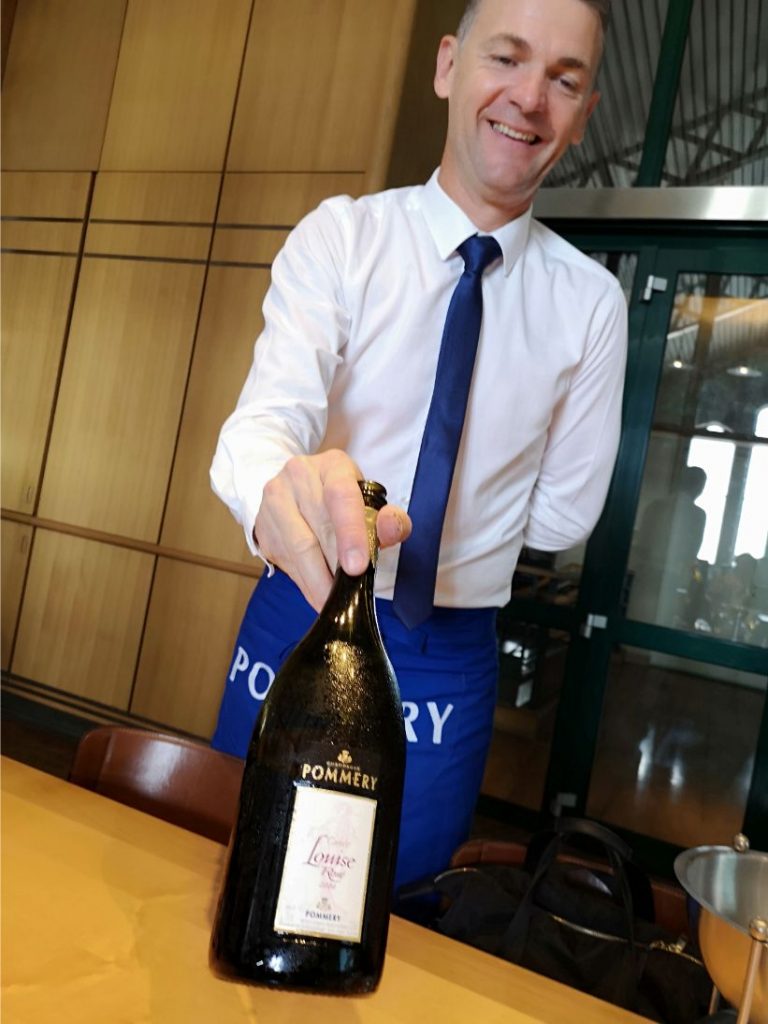After one of our biggest tasting days this summer when we reviewed more than 100 bottles of Champagne, James, Jack and I gathered around the best bottles and tasted them together all over again. The moment crystallized for us how diverse and interesting the world’s greatest sparkling wine has become.

A 2008 Cuvée Sir Winston Churchill Champagne from Pol Roger suitably paired with the American and British flag during a tasting at Pol Roger.
We tasted more than 350 Champagnes in July, visited several dozen wineries and met with many winemakers. We just couldn’t get enough of the best Champagnes we tasted this summer – we believe Champagne is delivering some of the highest quality and best value premium wines in the world at the moment.
Today’s best Champagnes emphasize both house style and winemaking prowess, highlighting the differences in the soils and climates of key areas and vineyards. This is very different from years ago when Champagne primarily relied on house blends, bottle-aging times and vintages.
Vintages, of course, do have a profound influence particularly in delivering structure and quality to Champagnes. The quality of the 2008 vintage Champagnes in our tasting last year shone through, exemplified by the 100-point 2008 Cristal, which was just one great example.
100-point Champagnes
In this year’s tasting it was hard to choose between the Jacquesson Dizy Corne Bautray 2008 and the Billecart-Salmon Champagne Le Clos St.-Hilaire Brut 2002 for top honors. Both are elite selections of outstanding parcels and both are the product of outstanding vintages. Both are awarded 100 points. Also note the great 2008 Dom Perignon, which we rated last year and is currently on the market, as an ambassador for this great vintage.
Some of the top Champagnes rated this year came from 2007, and show a brightness and energy, especially in blanc de blancs. “When I think of 2007 I think of 1995 and 2008 is 1996,” says Clovis Taittinger, the export director of his family’s Champagne house. The 2008 Blanc de Blancs and 2007 Rosé Champagne Comtes de Champagne from Taittinger both received 99-point ratings. “You have a style of our family Champagnes with 2007, 2005, and 2004. They are wines with good tension with a hyper elegance.”

The 2007 vintage is fresh and crisp for top Champagnes and even rosés.
However, the longer-term trend of warmer vintages in Champagne (and most of Western Europe) has also pushed some winemakers to capture greater natural ripeness in the vineyard, resulting in Champagnes with fuller flavors and denser textures. This gives greater vinous character to Champagnes but can make many heavy and over-ripe bottles, particularly in blanc de blancs. We prefer Champagnes with balance as well as richness.
A benefit of the hotter weather is that vineyard growers can use fewer chemicals against disease and pests, and organic and biodynamic viticulture is an option. Many now make a point of farming sustainably and they also make better wine as a result. This is a wonderful development in Champagne that we applaud – we look forward to more producers working this way.
The rise of natural and biodynamic Champagnes
It is impressive to see a maison the size of Louis Roederer delivering such outstanding quality from biodynamically farmed grapes. The work they are doing really sets a benchmark for other larger producers to follow. “In 2008 40 percent of the grapes for Cristal were biodynamically farmed,” says Chef de Cave Jean-Baptiste Lecaillon. “And 2012 is our first Cristal produced from 100 percent biodynamically farmed grapes.”
The entire Cristal estate was certified organic in 2018 and today 52 percent of Roederer’s production is organically certified.
Lecaillon is also looking to harvest riper grapes in Champagne. He is de-tuning Brut Premier to make it less bubbly and more vinous and inching toward greater vineyard-driven purity. A riper base year means lower dosage, lower pressure and a more fluid texture can be achieved. “I think texture is really the Roederer touch,” he says. “We attach a strong focus to texture in every step of production.”

James thought the Champagnes at Pommery were a big improvement in quality.
Producers like Selosse, Jacquesson and Roederer all pick later than many in the prized Côte de Blancs village of Avize, looking to get the full dimension of the chardonnay they harvest there. For many producers working organically, yields are typically 30 percent lower than the regional norm, so the quality is inherently driven from the vineyard in many respects for these producers. They are producing a very high level of quality and pushing them into an elite level of Champagne producers. Even the likes of Jacquesson’s non-vintage Cuvée 742, based on the 2014 vintage, delivers a level of power, style and interest that leaves many others in the dust.
High quality of 2012 Champagnes
There are a number of wines from the 2012 harvest coming into the market and this is a harvest that was really defined by a warm and dry summer, producing terrific quality and texture, particularly in pinot noir. Production was relatively small. This is a year that supports Champagnes with lower dosage and a greater reliance on fruit quality. The vintage shows extremely good balance and delivers high quality across a range of styles.
A number of winemakers said that 2013 is better than 2012 and should provide some excellent vintage Champagnes. “2013 is along the lines of 2008 with structure and freshness,” says Guillaume Roffiaen, head winemaker for Champagne Nicolas Feuillatte.
Champagne’s most recent vintage, 2018, is different than 2012. High temperatures burned acidity away in grapes and very high crop yields mean less than optimum quality in base wines. Some growers reported the equivalent of three harvests in one. High alcohol levels may also be a problem.
Yet, a number of producers are fascinated by the extreme nature of the harvest. “This notion of pH is very important in Champagne,” says Jean-Baptiste Geoffroy of Champagne Geoffroy. “Acidity is the image of the year and pH is the DNA of the terroir. I am sure of that because each year I have almost the same pH for the same plots, even in this extreme 2018 harvest.”
Personalities are coming through all the best Champagnes now, and they are derived from people as well as places and climates. We can expect great bottles of Champagne now and in the future.
– Nick Stock, Senior Editor. James Suckling, CEO and editor, contributed to the report








